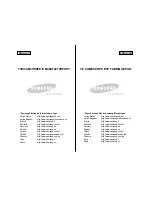
normCdf()
Catalog >
normCdf(
lowBound
,
upBound
[
,
μ
[
,
σ
]]
)
⇒
number
if
lowBound
and
upBound
are
numbers,
list
if
lowBound
and
upBound
are
lists
Computes the normal distribution probability
between
lowBound
and
upBound
for the
specified
μ
(default=0) and
σ
(default=1).
For P(X
≤
upBound
), set
lowBound
=
⁻
∞
.
normPdf()
Catalog >
normPdf(
XVal
[
,
μ
[
,
σ
]]
)
⇒
number
if
XVal
is
a number,
list
if
XVal
is a list
Computes the probability density function
for the normal distribution at a specified
XVal
value for the specified
μ
and
σ
.
not
Catalog >
not
BooleanExpr
⇒
Boolean expression
Returns true, false, or a simplified form of
the argument.
not
Integer1
⇒
integer
Returns the one’s complement of a real
integer. Internally,
Integer1
is converted to
a signed, 64-bit binary number. The value of
each bit is flipped (0 becomes 1, and vice
versa) for the one’s complement. Results
are displayed according to the Base mode.
You can enter the integer in any number
base. For a binary or hexadecimal entry, you
must use the 0b or 0h prefix, respectively.
Without a prefix, the integer is treated as
decimal (base 10).
If you enter a decimal integer that is too
large for a signed, 64-bit binary form, a
symmetric modulo operation is used to
bring the value into the appropriate range.
For more information, see
►
Base2
, page
21.
In Hex base mode:
Important:
Zero, not the letter O.
In Bin base mode:
To see the entire result, press
£
and then
use
¡
and
¢
to move the cursor.
Note:
A binary entry can have up to 64 digits
(not counting the 0b prefix). A hexadecimal
entry can have up to 16 digits.
Alphabetical Listing
123
Summary of Contents for TI-Nspire CAS
Page 4: ...4 Service and Warranty Information 249 Index 251 ...
Page 248: ...248 ...
Page 250: ...250 ...













































